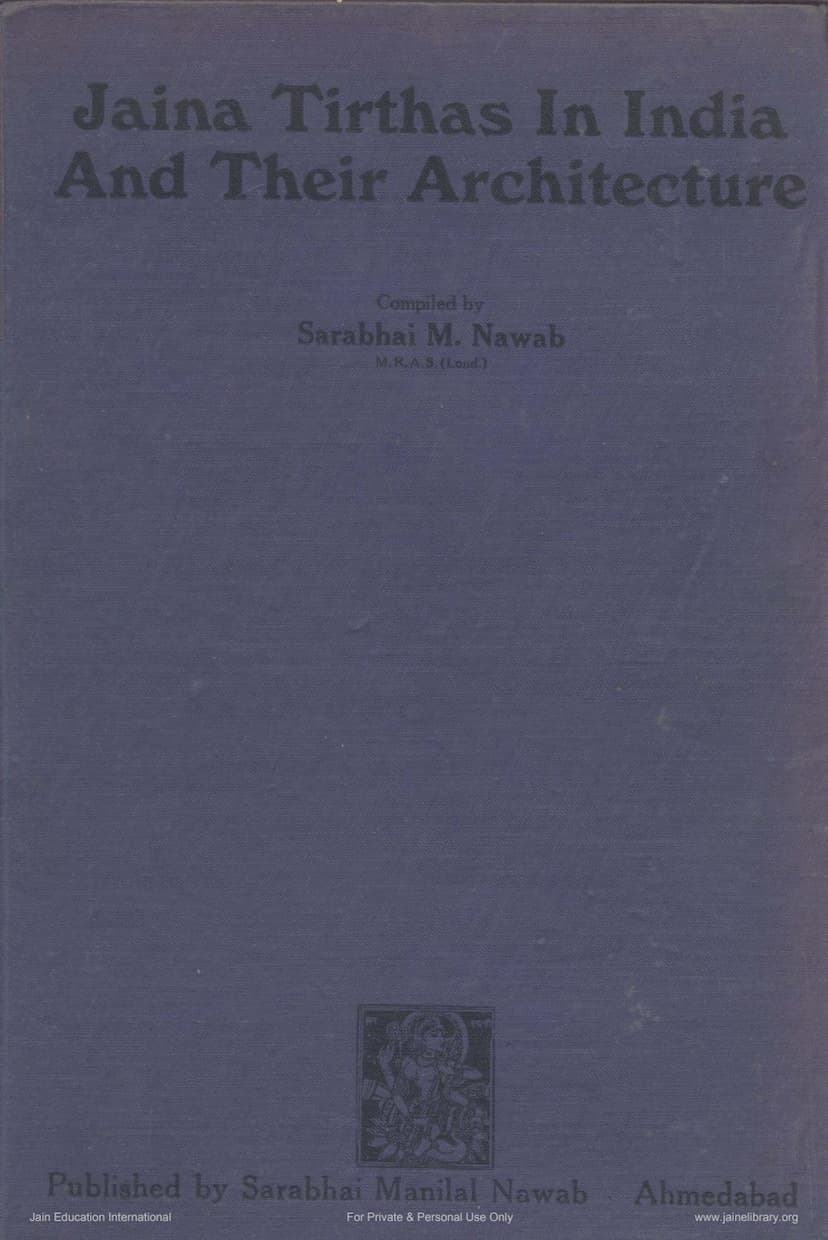Jaina Tirthas In India And Their Architecture
Added to library: September 2, 2025

Summary
Here's a comprehensive summary of the Jain text "Jaina Tirthas in India and Their Architecture" by Sarabhai Manilal Nawab:
Overall Purpose and Scope:
This book, "Jaina Tirthas in India and Their Architecture," compiled by Sarabhai Manilal Nawab, is a significant contribution to the study of Jain art and architecture. It aims to showcase the rich heritage of Jain holy sites (Tirthas) across India, with a particular focus on their architectural styles and the sculptures found within them. The book is a visual compendium, presenting numerous photographs of Jain temples, icons, and sculptures.
Author and Publisher:
The book is compiled by Sarabhai Manilal Nawab and published by Sarabhai Manilal Nawab himself. It is part of the "Sri Jaina Kala Sahitya Samsodhak Series," an English series. The first edition was limited to 150 copies.
Dedication and Foreword:
The book is respectfully dedicated to Sheth Maneklal Chunilal Shah, J.P., for his patronage and inspiration for the author's literary activities.
The Foreword, written by Sri Jinavijayaji, highlights the significant contributions of Jain scholars and patrons to Indian literature and architecture. It emphasizes that Jain architectural relics, though sometimes damaged by time and iconoclasts, remain matchless and form a national heritage of India. Jinavijayaji praises Sarabhai Manilal Nawab's dedication and untiring efforts in bringing to light hidden Jain art and architecture, acknowledging the difficulty of such an individual endeavor.
Introduction:
The Introduction, penned by Ravishankar Rawal, praises the publication as an invaluable service to Gujarat and Jainism. It discusses the deep connection between Jainism and fine arts, tracing the origins of Jaina image-making to periods contemporary with Buddhist art. Rawal touches upon the continuity of sculptural traditions from Vedic times and the emergence of iconic representation in Jainism and Buddhism. He also explores the possible influences on early Indian sculpture, such as Egyptian tomb architecture, and the development of temple architecture from earlier stupa and cave structures. He notes the Brahmanical influence on temple ornamentation and the subsequent incorporation of such decorative elements into Jain and Buddhist shrines. Rawal also comments on the regional artistic influences, particularly within Gujarat and its surrounding areas, and the shared artistic traditions across different religious sects, often attributed to the skills of specific artisan families like the Sompuras. He concludes by emphasizing Nawab's role in illuminating Jain culture and guiding art enthusiasts.
Content and Coverage:
The book meticulously documents various Jain Tirthas and their architectural features. The Table of Contents and the extensive list of plates and figures reveal a wide geographical and historical scope. It includes:
- Prominent Tirthas: Satruñjaya, Girnar, Taranga, Ranakpur, Talaja, Kadambagiri, Sametasikhara, Pavapuri, Lucknow, Calcutta, Kshatriyakunda, Rajagriha, Mathura, and many more.
- Types of Art and Architecture: The book features images of Tirthankaras, presiding deities (Yakshas and Yakshinis like Ambika, Chakreshvari, Padmavati), holy monuments, temple spires, carved pillars, ceilings, Jina images in various poses (like Kayotsarga), inscriptions, Ayagapata plaques, Charana-padukas (footprints), and even metal and wooden sculptures.
- Historical Context: The author attempts to date the sculptures and architectural styles, often referring to inscriptions and known historical periods. He discusses the development of Jaina iconography and architectural styles, drawing comparisons with Buddhist and Brahmanical art.
- Detailed Descriptions of Plates: Each plate is accompanied by a figure number and a brief description identifying the deity, monument, or artifact depicted and its location. The author also provides detailed notes on specific plates, discussing iconographic identifications, historical context, and artistic significance. For instance, he corrects misidentifications by other scholars regarding Mathura sculptures.
- Publisher's Appeal: Nawab makes an earnest appeal to users not to reproduce the pictures without his express permission, given the limited print run and the intention for devout Jainas and art lovers to appreciate the works.
Publisher's Statement on Retirement:
In the Publisher's Preface, Sarabhai Manilal Nawab expresses his intention to retire from the field of research after publishing this brochure. He cites reasons such as the dearness of materials during wartime, the apathy of wealthy Jains towards such endeavors leading to accumulated unsold copies, and his commitment to compiling a Jaina Directory for the Anandji Kalyanji Pedhi. He reflects on the vastness of architectural remains and the responsibility of preserving them for posterity, urging collective effort from the Jain community.
Key Themes and Observations:
- Preservation of Heritage: A strong underlying theme is the importance of preserving ancient Jain architectural and sculptural heritage. Nawab expresses concern about the scattered nature of these treasures and the need for conservation.
- Artistic Skill and Devotion: The book showcases the remarkable craftsmanship of ancient Jain sculptors and architects, whose work continues to inspire awe centuries later. It highlights the devotion of Jain patrons who funded these magnificent creations.
- Iconographic Details: Nawab meticulously identifies and describes various Jina images and associated deities, often delving into specific iconographic features and their significance within Jain tradition.
- Regional Art Styles: The book implicitly demonstrates the regional variations and influences on Jain art and architecture across different parts of India.
- Challenges in Publication: The publisher's preface reveals the personal sacrifices and challenges faced in producing such a work, underscoring the passion and dedication required to document this aspect of Jain heritage.
In essence, "Jaina Tirthas in India and Their Architecture" is a monumental photographic survey and scholarly endeavor that captures and presents the aesthetic and historical grandeur of Jainism's tangible legacy in India. It serves as a valuable resource for scholars, art historians, and anyone interested in the rich cultural heritage of Jainism.